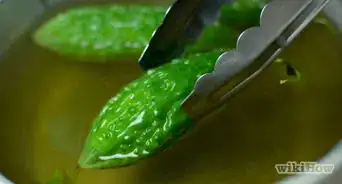This article was co-authored by Ollie George Cigliano. Ollie George Cigliano is a Private Chef, Food Educator, and Owner of Ollie George Cooks, based in Long Beach, California. With over 20 years of experience, she specializes in utilizing fresh, fun ingredients and mixing traditional and innovative cooking techniques. Ollie George holds a BA in Comparative Literature from The University of California, Berkeley, and a Nutrition and Healthy Living Certificate from eCornell University.
There are 9 references cited in this article, which can be found at the bottom of the page.
wikiHow marks an article as reader-approved once it receives enough positive feedback. In this case, 100% of readers who voted found the article helpful, earning it our reader-approved status.
This article has been viewed 727,213 times.
Blanching green beans involves two main steps: boiling the green beans for about two minutes, then putting them in ice water immediately after and until completely cooled.[1] When done correctly, you can achieve a crunchier texture, brighter color, and delicious flavor.
- Prep time: 10 minutes
- Cook time: 20 minutes
- Total time: 30 minutes
Steps
Blanching Your Beans
-
1Prepare your green beans. Rinse your beans thoroughly with water and snap the ends off of each bean.
- Only snap about a quarter inch off of the ends. Try to leave as much of the bean intact.
- Snapping too much off the ends leaves the inside of the bean exposed. This can cause a loss of flavor and crunch when boiling them in water.[2]
- You can also fill your prep sink with cool water—simply bathe the beans and drain.
-
2Salt a large pot of water. Salting is crucial for seasoning the beans as well as preserving their natural taste.
- Though you do not have to include salt in your water, doing so will help prevent nutrients and flavors from seeping out of your beans.[3] Salted water has a higher density than the water inside the beans. This helps keep most of the taste concealed in your beans rather than having them leak into the boiling water.
- Salt your water liberally. The general rule of thumb is that blanching water should be "ten times saltier than the sea." If you have trouble judging by taste, simply add a couple of tablespoons of kosher salt for every quart of water in your pot.
- Salting your beans generously helps maintain that bright green color, which is great if you intend on presenting a colorful dish. It also ensures that the beans will be seasoned evenly.
- Don't worry about your beans tasting too salty. They will only be in the boiling water briefly and won't soak up as much salt as you think.[4]
Advertisement -
3Place your pot of water on the stove to boil. Make sure the water volume is at least twice as much as the amount of beans you intend to blanch.
- Though you may be blanching only a few green beans, using a big pot is ideal because it minimizes the length of boiling time. The goal of blanching is to cook the beans as quickly as possible to avoid losing crunch and color.
- Set your pot to high heat so your water can reach a rolling boil. Pay attention to the bubbles in your pot. Small bubbles forming at the edges of the pot are just air bubbles from the water and don't necessarily mean your water is boiling. When big bubbles begin to steadily stream from the bottom of the pot, your water is ready to go.[5]
-
4Prepare an ice bath. An ice bath is essential for the second main step of blanching, which is "shocking" your beans in cold water to stop the cooking process.
- Fill a large bowl with water that is cold or at room temperature. Grab some ice cubes from your freezer and distribute them evenly throughout the water.
- Avoid preparing your ice bath early in your cooking process. The goal of shocking your beans is to stop the cooking that is still taking place inside the bean. Leaving your ice bath out at room temperature may decrease the effectiveness of shocking your beans.
- Don't prepare the ice bath after the cooking process. Shocking needs to occur immediately after beans have been boiled so that they do not become overcooked in their own steam. Also avoid preparing an ice bath while your beans boil. Since it is a quick process, you can easily lose track of time and overcook your beans.
-
5Place your green beans into the boiling water a few at a time. Let them sit in the water for 3 minutes.[6]
-
6Remove the green beans from the pot. Use tongs or a slotted spoon to carefully scoop them out of the boiling water.
- Don't feel rushed. Although blanching requires speed, it also requires care. You don't have to scoop out all of your green beans in one go.
-
7Place your green beans in the ice bath immediately. As you scoop out the beans from your water, immerse them evenly in the bowl of ice water.
- Avoid setting your beans down on a surface before shocking them in water. The longer your beans sit, the more they continue to cook.
- Keep your beans in the ice water until they have cooled down completely. Removing them before they have fully cooled allows cooking to continue from the inside out, which can result in a mushy final product.[9]
- Also avoid keeping the beans in the ice bath for too long. If you can't feel any more warmth with your fingertips, the beans are likely cooled. Keeping the beans in the water for too long risks making them heavy and soggy.[10]
-
8Wrap the green beans in a paper towel. Allow them to fully dry before eating or mixing them with other foods.
- Pat your green beans while they are inside the paper towel. This will help speed up the drying process.[11]
- Skipping the drying process risks making the beans soggy and defeating the purpose of blanching, which is to achieve a crispy texture.
Other Blanching Techniques
-
1Blanch your green beans in the microwave. Substitute a casserole dish and microwave for a pot and stove.
- The steps are generally the same as blanching on the stove with a few minor tweaks. Instead of keeping your green beans whole, chop them into small pieces. Put salt on them directly instead of in the water.
- Fill a casserole dish with 3 US quarts (3,000 ml) of water. Place two cups of green beans into the dish and cover. Microwave the casserole dish for 5-6 minutes, stopping to stir at least twice throughout the cooking process. Shock and dry the beans as you normally would after boiling.
- This technique is best for smaller quantities of green beans and for when you may not have access to a pot or stove. Know that microwaving may not be as effective as boiling when trying to achieve crunchier and brighter green beans.[12]
-
2Use steam to blanch your green beans. Replace your pot and water with a basket and steam.
- Use a pot with a tight lid and a steam basket that holds food at least three inches above the pot. Put an inch or two of water in the pot and bring it to a boil. Place your green beans in a single, even layer so that the steam reaches all parts quickly.[13] Cover the pot with the lid and keep the heat on high for about 3-4 minutes. Shock and dry the green beans how you typically would.
- Steam blanching, while a nice alternative to water blanching, is not as efficient. It takes approximately 1 1/2 times longer to steam blanch green beans than to water blanch them.[14]
- Using steam is typically advised for specific vegetables, such as broccoli or sweet potatoes. Though you can blanch all vegetables in steam, water blanching green beans is quicker and more effective.
-
3Sauté your green beans in a skillet after blanching. Though this is not a substitute for water blanching, it is a nice flavor supplement to your already crispy green beans.[15]
- After drying your beans, heat a large skillet over medium heat. Add oil and butter and Sauté the mixture for about 30 seconds. No exact measurements are required; just add enough oil and butter to fully coat your beans. Add the beans and continue to Sauté until they are coated in butter and heated through. Remove the beans from the skillet and add lemon zest, salt, and pepper.
- For even greater flavor, mix red pepper flakes and garlic into your butter before sauteing your beans.
Expert Q&A
-
QuestionWhat to do with green beans after blanching?
 Ollie George CiglianoOllie George Cigliano is a Private Chef, Food Educator, and Owner of Ollie George Cooks, based in Long Beach, California. With over 20 years of experience, she specializes in utilizing fresh, fun ingredients and mixing traditional and innovative cooking techniques. Ollie George holds a BA in Comparative Literature from The University of California, Berkeley, and a Nutrition and Healthy Living Certificate from eCornell University.
Ollie George CiglianoOllie George Cigliano is a Private Chef, Food Educator, and Owner of Ollie George Cooks, based in Long Beach, California. With over 20 years of experience, she specializes in utilizing fresh, fun ingredients and mixing traditional and innovative cooking techniques. Ollie George holds a BA in Comparative Literature from The University of California, Berkeley, and a Nutrition and Healthy Living Certificate from eCornell University.
Private Chef & Food Educator Feel free to toss them with garlic, lemon juice, olive oil, minced shallot, salt, and pepper.
Feel free to toss them with garlic, lemon juice, olive oil, minced shallot, salt, and pepper. -
QuestionCan I refrigerate blanched beans overnight and then saute them in a large skillet with butter and lemon zest?
 KateKatey GirlCommunity AnswerYes, you can. The best way to cook them to desired doneness is to taste as you go.
KateKatey GirlCommunity AnswerYes, you can. The best way to cook them to desired doneness is to taste as you go. -
QuestionWhat can you do with the water from blanched green beans?
 Community AnswerLet the water cool, then water your outdoor plants with it. The water contains some nutrients from the beans. There is not sufficient salt in the water to damage the roots. Alternatively, you can use the water as a base for homemade soup.
Community AnswerLet the water cool, then water your outdoor plants with it. The water contains some nutrients from the beans. There is not sufficient salt in the water to damage the roots. Alternatively, you can use the water as a base for homemade soup.
Warnings
- Of course, be careful with boiling water.⧼thumbs_response⧽
References
- ↑ http://www.reluctantgourmet.com/how-to-blanch-foods/
- ↑ http://www.reluctantgourmet.com/how-to-blanch-foods/
- ↑ http://www.reluctantgourmet.com/how-to-blanch-foods/
- ↑ http://allrecipes.com/howto/blanching-and-shocking-vegetables/
- ↑ http://www.digsmagazine.com/nourish/nourish_cluelesscooks-boilwater.htm
- ↑ https://nchfp.uga.edu/how/freeze/blanching.html
- ↑ http://allrecipes.com/howto/blanching-and-shocking-vegetables/
- ↑ https://www.noreciperequired.com/technique/how-blanch-green-beans
- ↑ http://allrecipes.com/howto/blanching-and-shocking-vegetables/
- ↑ http://www.reluctantgourmet.com/how-to-blanch-foods/
- ↑ http://www.eatbydate.com/how-to-blanch-green-beans/
- ↑ http://nchfp.uga.edu/how/freeze/blanching.html
- ↑ http://nchfp.uga.edu/how/freeze/blanching.html#time
- ↑ http://nchfp.uga.edu/how/freeze/blanching.html#time
- ↑ http://www.foodnetwork.com/recipes/patrick-and-gina-neely/green-beans-with-lemon-and-garlic-recipe.html
About This Article
Before you blanch green beans, rinse them thoroughly and snap the ends off of each bean. Bring a pot of heavily salted water to a rolling boil. Fill a bowl full of ice water. Place your green beans into the boiling water a few at a time, letting each batch sit for about 2 minutes. Use tongs to carefully scoop the beans out of the boiling water. Immediately immerse them in the bowl of ice water. Leave the beans in the ice water until they have completely cooled, then wrap them in a paper towel until you are ready to serve them.



















































